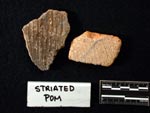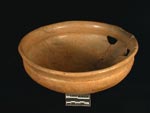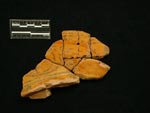
| FAMSI © 2004: Arturo René Muñoz |
|||||||||||||||||||||||||||||||||||||||||||||||||||||||||||||||||||||||||||||||||||||||||||||||||||||||||||||||||||||||||||||||||||||||||||||||||||||||
|
The Ceramic Sequence of Piedras Negras, Guatemala: Type and Varieties The Pom Ceramic Phase (A.D. 175–A.D. 350) Pom is a provisional grouping of types representing a Terminal Preclassic phase. Ceramics belonging to this phase have been found in only a few locations across the site, all located within the southern sector of the site, with the largest deposits found in excavations in front of Strs. R-2 and R-4. The current sample of Pom phase ceramics consists of approximately 900 diagnostic sherds and two vessels. The initial date of this phase is based on comparisons with other sites. The types defining the Pom phase all appear after about A.D. 150 at sites elsewhere in the Petén. Their appearance at Piedras Negras is placed later, at about A.D. 175 in order to accommodate for Piedras Negras peripheral location. The end of this period is established by appearance of Tzakol modes and types at about A.D. 350. In most respects, the Pom phase ceramics are indistinguishable from Abal phase materials. Pom phase deposits are distinguishable, however, from Abal assemblages by the appearance of modes and forms diagnostic of the Terminal Preclassic elsewhere in the Petén. These include Usulután style decoration on hooked-grooved rim plates, Aguila-like orange slips, the use of mammiform supports, and the initial appearance of polychrome decoration. At Piedras Negras the most diagnostic Pom types include Ixcanrio Orange Polychrome, Metapa Trichrome, and Sacluc Black-on-Orange. Though these types are useful markers for identifying Pom phase assemblages, their rarity limits their diagnostic utility. However, contemporary with the appearance of these types at Piedras Negras, is the appearance of the distinct, locally produced and widely distributed type, Otatal Orange Polychrome. Otatal is generally decorated with parallel red and black lines painted over an Aguila-like orange slip. This combination of slip, palette, and design is restricted to this period at Piedras Negras, and is similar to the slip and decoration found on Terminal Preclassic vessels from Altar de Sacrificios (Adams 1971, Fig 26b, c; also Tikal illustration #22). Otatal Orange Polychrome and vessel forms rare elsewhere in the Petén and absent in the Abal complex (e.g. dishes with incurving walls and thickened rims, dishes with composite profiles and thickened and nearly vertical rims) may represent the beginning of a local style resulting from Piedras Negras isolation from Central Petén trends.
|
|||||||||||||||||||||||||||||||||||||||||||||||||||||||||||||||||||||||||||||||||||||||||||||||||||||||||||||||||||||||||||||||||||||||||||||||||||||||
|
Text links to all pages at this site are available at the FAMSI INDEX |
|||||||||||||||||||||||||||||||||||||||||||||||||||||||||||||||||||||||||||||||||||||||||||||||||||||||||||||||||||||||||||||||||||||||||||||||||||||||


